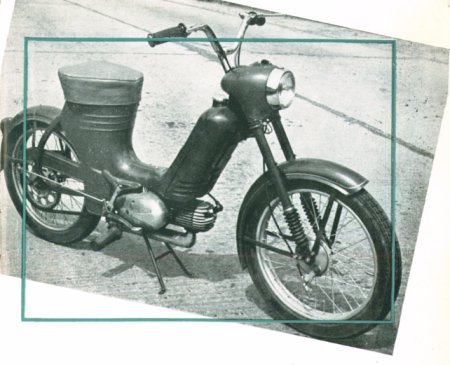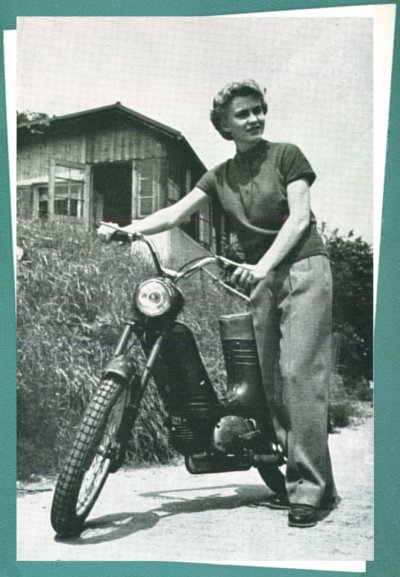|
 Dr JAN SCHULMANN Dr JAN SCHULMANN
The smallest member of the JAWA family has become by now a usual sight on Czechoslovak roads. About a year ago it still drew attention of pedestrians and motorists, wherever it appeared. But by now many thousands are running and they became an everyday thing like everything to which people got accustomed. Nobody will stop now or look back and perhaps here and there somebody may think for himself, how fast the JAWA 50 Ultra-Lightweight became widespread. And perhaps somebody may say to himself: It wasn't here a year ago and now it can be seen every day and everywhere, how quickly life changes and how quickly does one get used to new things! And in the next moment he will forget all about it. Such is life. It occurs to nobody, how much thinking, energy and work was required before the conception lay-out originated, how many tests and trials before the prototype was proved, how much more effort before production was organised, how much work of skilled hands is necessary for the 4,800 machining operations before those 1,500 components of which it consists, are made. Nobody rakes his brains with it. Here it is and that is all. Soon it will appear on the roads of other countries, will create interest at the beginning and in time will become a thing of everyday as it is already in its homeland. And so it should be. If people were to stop at every novelty, technical progress would not go so fast ahead.
The JAWA Works had a wealth of experience with their JAWA ROBOT lightweight of which many thousands were manufactured. In spite of the fact that this model is not in production since 10 years, many of these machines are still running. The ROBOT had three outstanding qualities: it was robust, reliable and had riding qualities inferior to none. Chief designer J. Jozif, the father of the ROBOT, gave these qualities also to the new JAWA 50 Ultra-Lightweight.
Because of its robust construction the JAWA 50 differs markedly from autocycles of bicycle conception. Higher weight is the direct result of this differing conception. It could be said that this is a disadvantage, but it is not so in reality. It is just this difference in weight which makes that the JAWA 50 is marked with exceptional stamina and life, intended by the designer. For the JAWA 50 is not intended only for running on the perfect surface of city streets or on smooth concrete and tarmac roads. Why, all people do not live in cities and there are not everywhere roads without a single unevennes of the surface, smooth like a table board. And these people want to ride as well and need an individual means of transport for going to work, for various errands and for pleasure, at least as much as people living in cities or in their near surroundings. Even much more so, because communal transport in their case is not always available. And that is where robustness asserts itself. It is all the same to the JAWA 50 if you will load her for example with a sack of potatoes or if you will ride "flat out" over bad roads full of potholes. The suspension will not butt and no spoke in the wheel will break.
And because the JAWA 50 is also intended for people without technical knowledge, it has to be capable of bearing the handling of its owner who, maybe, was not given the least bit of mechanical sense (begging your pardon, ladies); it has to bear such handling without defects and without fatigue. The same as the frame will support loads that are out of all proportion and riding on the worst surface, so will the engine bear the roughest handling. If it will be at least a little decently run in, i.e. if the throttle during the running-in period will not be opened more that two thirds, then it will stand everything and give a performance that will surprise everybody. To reduce the possibility of defects to a minimum no twist grip gear change was used, but that by the tried out and well proved foot selector. And so if you will not stamp with all your weight with an iron studded boot on the gear change lever no defect can occur to the gear change mechanism. That it is so, has been demonstrated: the public witnessed when Works' riders were jumping with JAWA 50 machines to a distance of several yards and when the machines carried a group of four or even six people!
With the JAWA 50 you can ride through water, on sand, on gravel, mud, over rocky paths or sodden meadows, etc. The superiority of its riding qualities will be best apparent on slippery ground. This too has been demonstrated in practice. During the last hard winter not one "old hand" was surprised when on an ice-bound or snow covered road he was overtaken by somebody riding a JAWA 50 whereas he hardly dared to take a deep breath in order to keep his machine of many times the capacity on wheels. The writer himself made this bitter experience, when riding a 250cc motorcycle at a speed of 30 mph on icy pavé, much too slippery even for pedestrians, he was overtaken by a youngster riding carelessly a JAWA 50 at full throttle. But even this is not all. Several JAWA 50 riders took part this year in five reliability trials in Czechoslovakia, two of which were winter events. All the machines completed the trial winning a "gold". And which is more, at one of the winter trials they crossed sections no other motorcycle managed to overcome. Till today a story of this trial is told among riders: on a steeply descending winding field track, covered with a thick layer of hard trodden snow, three (standard!) JAWA 50 were quietly coming down, whilst riders on powerful trials machines had much trouble with the descent. One of them became furious and decided that he must keep up with the "small ones". He shouldn't have done that! The three JAWA 50 completed the descent without difficulty, but the infuriated rider lost control over his machine in one of the many bends, skidded, left the road and entered at such pace a deep snowdrift that the freeing of his own person and machine cost him several valuable marks.
Recently another proof was given of the perfect properties, handling and outstanding qualities of these machines. In the northern part of Czechoslovakia there is a mountain range the highest peak of which - Sněžka - reaches an altitude of some 5,275 ft. (1,608 m) above sea level. Next to the High Tatra giants towering to the respectful height of over 8,530 ft. (2,600 m) it is the highest mountain in the country. To the top of this mountain, where no road, only two rocky tourist paths are leading, a publicity trip with three JAWA 50 was undertaken. There were many who did not conceal their doubts with regard to the possibility of success of such an enterprise. They were mistaken. Already on the way to the mountains a cruising speed of nearly 34 mph (54.3 kmph) was achieved on the roads, How many cars and powerful motorcycles achieve higher cruising speeds? Admitted, some vehicles reached the top of Sněžka before, but the smallest was a trials motorcycle of three times the capacity. But to be brief. The JAWA 50 did not only manage to climb the path on which their predecessors reached the summit, but they even repeated the climb taking the direct path without hairpins, the path on which no motorcycle rode ever before, the average rate of ascent of which is over 30%! No trouble was experienced and the engines did not become overheated. The ascent to Sněžka was preceded by the climb to its foot. The difference in level over 10 miles (16 km) where rocks alternated with rain soaked ground and tree roots amount to 3,845 ft. (1,124 m) and this section was covered in one and a half hours. Can a more convincing proof be given?
In one more respect does the JAWA 50 differ from the autocycle. It is not equipped with pedals, it has footrests. Pedals are a thing of the past. Autocycles and mopeds have them, because in the opinion of legislators in some countries a "motorised bicycle" without pedals would cease to be a "bicycle" and would become motorcycle. And because the "bicycle" in these countries is not subjected to registration or need not be equipped with a registration number, is free from road tax or need not be insured, its rider need not have any driving licence, etc., manufacturers have  to make autocycles with pedals. Recently expert circles in some countries declared war on pedals and a fierce struggle is raging about the whole matter. Experts are proving the uselessness of the pedal, for the power of a modern engine of 50 cc capacity is sufficient to master any gradient without the assistance of pedals. They are proving further that riding on a machine with footrests is much safer (and incomparably more comfortable) than on a machine with pedals and that the point of view of the authorities is paradoxical as they are offering advantages to vehicles of a conception ensuring less safety. These views are correct and will surely prevail in time. And due to their influence a change of the regulations will come about. These were the considerations, which led the designer of the JAWA 50 to equip it with footrests. And so voices abroad are now being heard pointing out the conception of the JAWA 50 Ultra-Lightweight as the forerunner of future development of these smallest two-wheelers. to make autocycles with pedals. Recently expert circles in some countries declared war on pedals and a fierce struggle is raging about the whole matter. Experts are proving the uselessness of the pedal, for the power of a modern engine of 50 cc capacity is sufficient to master any gradient without the assistance of pedals. They are proving further that riding on a machine with footrests is much safer (and incomparably more comfortable) than on a machine with pedals and that the point of view of the authorities is paradoxical as they are offering advantages to vehicles of a conception ensuring less safety. These views are correct and will surely prevail in time. And due to their influence a change of the regulations will come about. These were the considerations, which led the designer of the JAWA 50 to equip it with footrests. And so voices abroad are now being heard pointing out the conception of the JAWA 50 Ultra-Lightweight as the forerunner of future development of these smallest two-wheelers.
Slowly draws the trying-out period of the JAWA 50 at home to its end. It was shown, with what success this trying-out period is passing. The day, when the JAWA 50 will serve faithfully side by side with its bigger brothers the wide public abroad, is nearing. That it will serve with success all those who need a cheap and good individual means of transport, capable of fulfilling its task under most difficult circumstances, can be relied upon. The JAWA 50 will convince everybody.
Taken from Czechoslovak Motor Review
issue 11 1956, for jawamoped.com
|